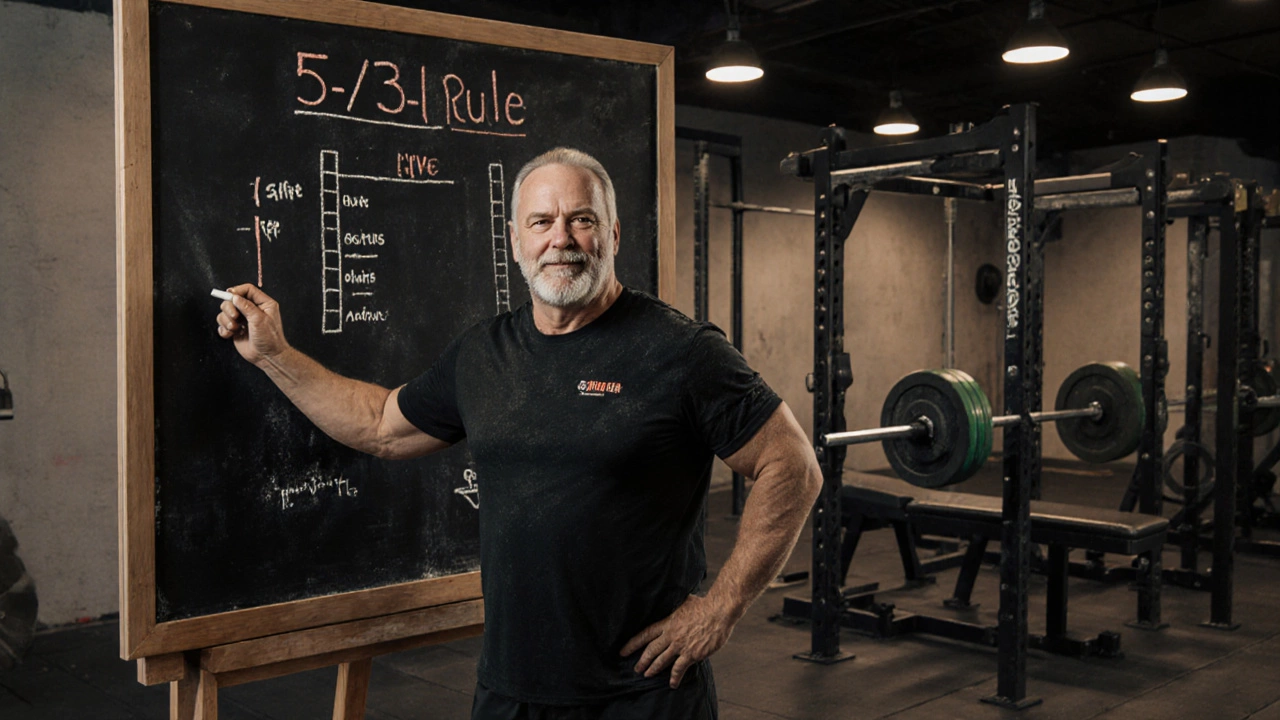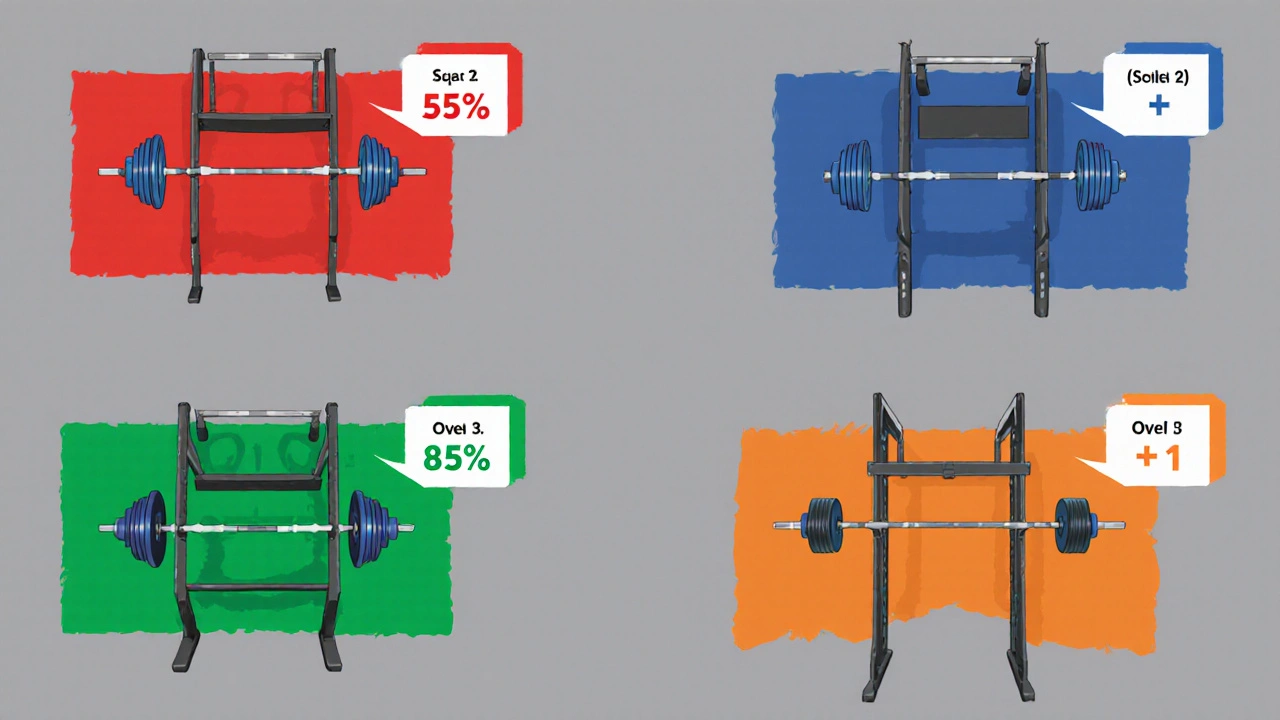
5/3/1 Training Max Calculator
Your Training Max:
-
This is 90% of your one-rep max, used in the 5/3/1 program.
In the 5/3/1 program, your training max (TM) is calculated as 90% of your true one-rep max (1RM). This accounts for the fact that you may not be able to lift your full 1RM in the gym due to fatigue, nervous system limitations, or safety concerns.
Example: If your 1RM for bench press is 200 lbs, your training max would be 180 lbs (200 × 0.90).
Quick Summary
- The 5 3 1 rule is a simple, periodized rep scheme for building strength.
- It uses four main lifts: squat, bench press, deadlift, and overhead press.
- Progression is based on a "training max" that’s 90% of your true one‑rep max.
- Weekly cycles follow 5 reps, 3 reps, then 1 rep, with percentages 65‑75‑85, 70‑80‑90, and 75‑85‑95.
- Accessory work can be customized, but the core cycle stays the same.
What is the 5/3/1 Rule?
When you hear the phrase 5 3 1 rule, most lifters think of a rep pattern that promises steady strength gains without burning out. 5/3/1 rule is a strength‑training program created by Jim Wendler, a former powerlifter turned coach. The core idea is to work the four big compound lifts once a week, cycling through weeks that call for five reps, three reps, and a single heavy rep. By keeping the percentages modest and the volume low, the method lets you lift heavier for years.
Who is Jim Wendler?
Jim Wendler is a veteran powerlifter who competed at the national level in the early 2000s. After retiring from competition, he spent a decade coaching athletes of all levels. His experience with plateaus and burnout led him to design the 5/3/1 rule in 2009, publishing the program in a best‑selling book and a series of online videos. Wendler’s philosophy centers on consistency, simplicity, and progressive overload.
Core Principles of the 5/3/1 Rule
Four pillars hold the whole system together:
- Training Max (TM) - Instead of using your real one‑rep max (1RM), you calculate 90% of it. This lower number protects against overreaching.
- Rep Scheme - Each four‑week cycle follows a 5‑rep, 3‑rep, and 1‑rep pattern, with the final week serving as a deload.
- Progression - After each cycle, you add 5lb (2.5kg) to upper‑body lifts and 10lb (5kg) to lower‑body lifts.
- Accessory Work - Assistance exercises are optional but should complement the main lift and address personal weaknesses.

How to Calculate Your Training Max
First, find your true 1RM for each of the four lifts. If you can’t test a max safely, use a reliable 5‑rep estimate and apply the Epley formula: 1RM ≈ weight × (1 + reps/30). Once you have the 1RM, multiply by 0.90.
Example for the bench press:
- True 1RM = 200lb.
- Training Max = 200lb × 0.90 = 180lb.
All percentages in the program are based on this 180lb figure.
Weekly Layout
The standard template runs four days a week, each devoted to a different main lift.
| Day | Lift | Week 1 (5 reps) | Week 2 (3 reps) | Week 3 (1 rep) | Week 4 (Deload) |
|---|---|---|---|---|---|
| Monday | Squat | 65% × 5, 75% × 5, 85% × 5+ | 70% × 3, 80% × 3, 90% × 3+ | 75% × 5, 85% × 3, 95% × 1+ | 40% × 5, 50% × 5, 60% × 5 |
| Tuesday | Bench Press | 65% × 5, 75% × 5, 85% × 5+ | 70% × 3, 80% × 3, 90% × 3+ | 75% × 5, 85% × 3, 95% × 1+ | 40% × 5, 50% × 5, 60% × 5 |
| Thursday | Deadlift | 65% × 5, 75% × 5, 85% × 5+ | 70% × 3, 80% × 3, 90% × 3+ | 75% × 5, 85% × 3, 95% × 1+ | 40% × 5, 50% × 5, 60% × 5 |
| Friday | Overhead Press | 65% × 5, 75% × 5, 85% × 5+ | 70% × 3, 80% × 3, 90% × 3+ | 75% × 5, 85% × 3, 95% × 1+ | 40% × 5, 50% × 5, 60% × 5 |
“+” indicates you should try to add a few extra reps beyond the target if you feel strong that day.
Accessory Work: Choosing the Right Extras
Wendler suggests three main assistance styles:
- Boring But Big (BBB) - 5 sets of 10 reps of the main lift at ~50% TM.
- Tri‑Set - Three different exercises targeting the same muscle group, three sets each.
- Conditioning - Light cardio or sled work to aid recovery.
Pick the style that matches your goal. If you’re a powerlifter, BBB helps reinforce technique. If you’re a general fitness enthusiast, a tri‑set of rows, pull‑ups, and face‑pulls rounds out the day.
Common Mistakes and How to Fix Them
Even simple programs can go sideways when you ignore key details.
- Skipping the Training Max. Using your real 1RM leads to rapid fatigue. Always stick to the 90% rule.
- Adding Too Much Weight. The 5‑lb/10‑lb increments are deliberate. If you’re stuck, stay at the same TM for another cycle.
- Neglecting Deload Week. The fourth week is essential for recovery. Skipping it often results in stalled progress.
- Choosing Random Accessories. Pick assistance that supports the main lift, not just any bicep curl.

Variations on the 5/3/1 Theme
Many coaches have tweaked the original template to suit specific needs.
- 5/3/1 for Beginners. Uses higher percentages (75‑85‑95) and adds more volume in the first two weeks.
- 5/3/1 for Hypertrophy. Swaps the BBB set for 4×12 of a secondary lift, emphasizing muscle size.
- 5/3/1 for Powerlifting. Adds a “eGPP” (extra general physical preparedness) day for speed work.
Pick a variation only if the base program feels too easy or you have a clear secondary goal.
How 5/3/1 Stacks Up Against Other Programs
| Program | Primary Goal | Frequency | Complexity | Typical Progression |
|---|---|---|---|---|
| 5/3/1 | Steady strength | 4 days/week | Low | +5lb upper / +10lb lower per cycle |
| Starting Strength | Maximum strength fast | 3 days/week | Low | +5lb per session |
| StrongLifts 5×5 | Strength + hypertrophy | 3 days/week | Low‑Medium | +5lb per session |
If you love simplicity and want a program that can run for years, 5/3/1 usually wins. If you need quick novice gains, Starting Strength might feel faster.
Getting Started: Your First 4‑Week Cycle
Follow these steps to launch the program without confusion:
- Test or estimate your 1RMs for squat, bench, deadlift, and overhead press.
- Calculate each Training Max (TM) by multiplying the 1RM by 0.90.
- Write down the percentages for weeks 1‑4 (see the weekly layout table).
- Choose an assistance style (BBB is a safe default).
- Mark a deload week on your calendar; treat it as a light, recovery‑focused session.
Stick to the plan for at least 12 weeks (three full cycles) before deciding whether to add a new variation.
Frequently Asked Questions
Can I use the 5/3/1 rule if I only train three days a week?
Yes. Many lifters run a three‑day version by pairing two lifts on one day (e.g., squat + bench) and keeping the other two days for deadlift and overhead press. Just keep the weekly percentages the same and adjust volume to avoid overtraining.
What if I can’t hit the “+” reps on a heavy set?
The “+” is optional. It’s a signal to push a little harder if you feel good, but never at the expense of form. If you miss the extra reps, stay at the same TM for the next cycle.
Do I need a spotter for the 5/3/1 bench days?
A spotter is safest for the heavy 1‑rep sets, especially when you’re pushing 95% of your TM. If you train alone, use safety pins or a power rack to catch the bar.
Can I incorporate cardio while following 5/3/1?
Absolutely. Light cardio on off‑days (e.g., brisk walking, cycling, or rowing for 20‑30 minutes) helps recovery without interfering with strength gains.
How long can I stay on the same program before changing?
Most lifters stay on 5/3/1 for 6‑12 months, completing 9‑12 cycles. When progress stalls for two consecutive cycles, consider a deload of 2‑4 weeks or switch to a variation like the 5/3/1 for Hypertrophy.